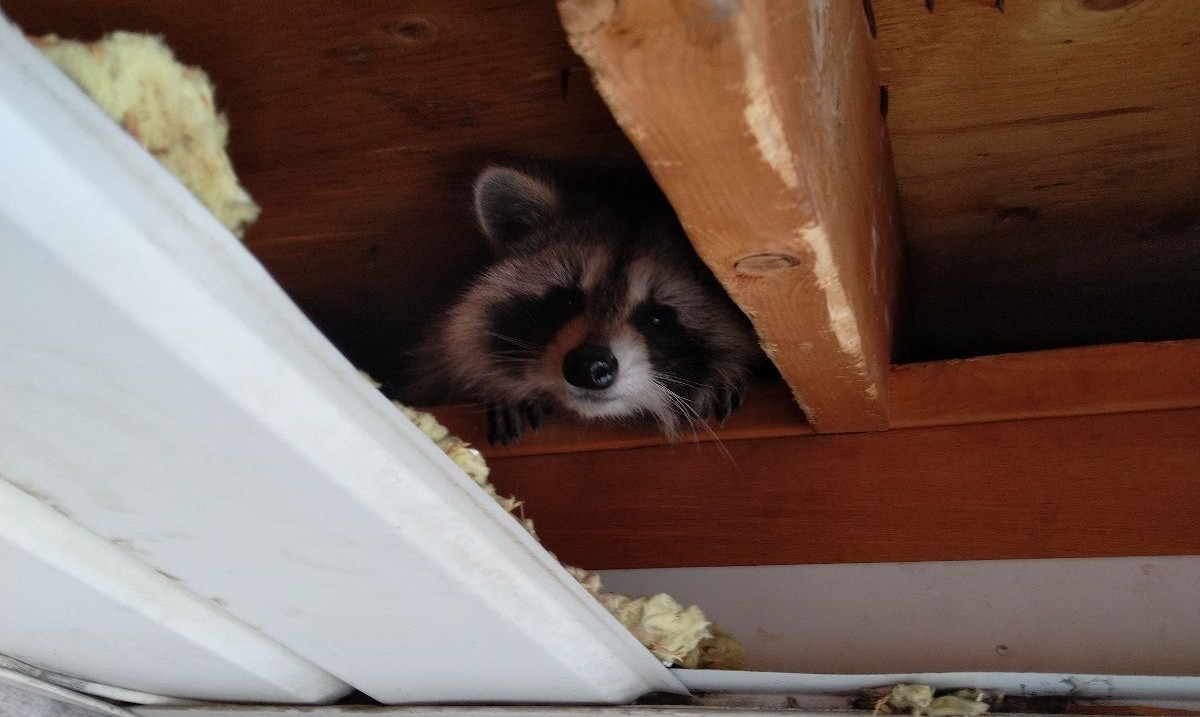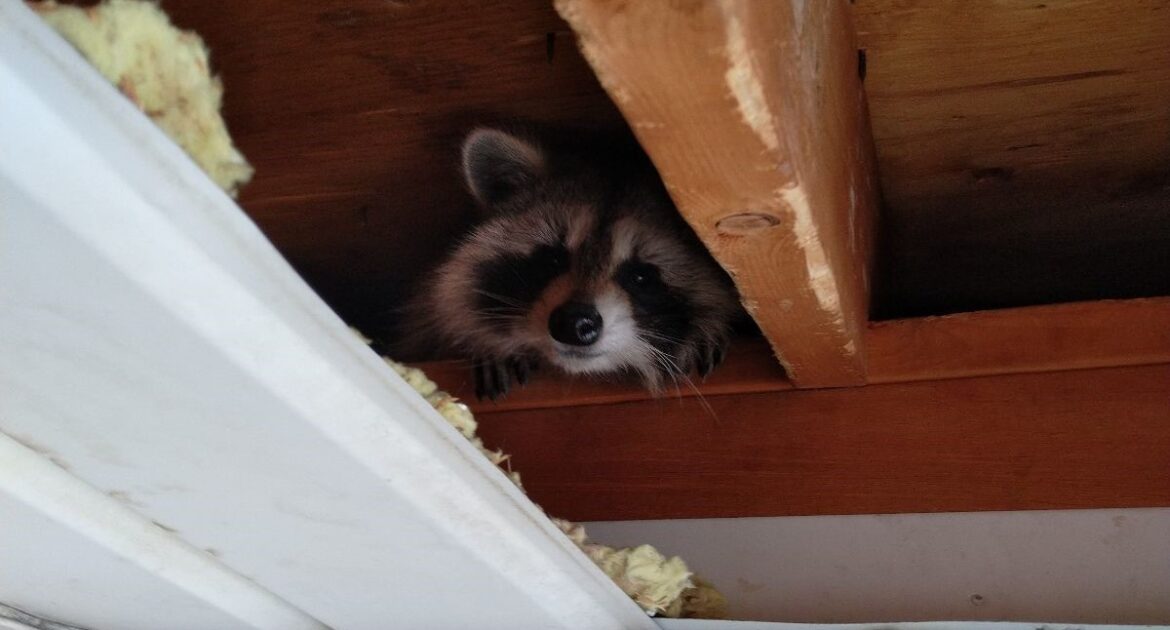Raccoons are resourceful animals that thrive in urban spaces like London, often seeking shelter in attics and crawling across roofs in search of food or safety. While they’re fascinating creatures, the damage they cause can lead to expensive repairs and sleepless nights for homeowners.
Raccoon-proofing tips for London homes are essential to safeguard your property, prevent costly repairs, and reduce risks for your family. This guide provides actionable advice to help homeowners implement roof protection from raccoons in London and effectively prevent raccoon attic damage.
Raccoon-Proofing Tips For London Homes
Our experience shows that most raccoon-related damage occurs because they exploit vulnerabilities in the structure of homes. They can claw through shingles, chew through wood, or squeeze through gaps in the roof. Here’s how you can raccoon-proof your home effectively:
- Inspect and Seal Entry Points: Regularly check for gaps or weak areas in your roof, soffits, vents, and chimneys. Use heavy-gauge steel mesh or durable materials to seal them.
- Install Chimney Caps and Roof Vents: Ensure all chimneys have sturdy caps and that roof vents are protected with screens capable of withstanding raccoon activity.
- Trim Trees and Remove Ladders: Keep tree branches trimmed to prevent access to your roof. Remove ladders or items raccoons can use to climb to your roof.
- Secure Garbage and Compost: Use raccoon-proof bins with locking lids. Their strong sense of smell can lure them closer to your property.
- Outdoor Lighting and Noise Deterrents: Raccoons are nocturnal and dislike well-lit areas. Motion-activated lights or noise deterrents can discourage them from approaching your home.
- Maintain Your Home: Ensure your roof and siding are in good repair, as older, weaker materials are easier for raccoons to tear through.
Proactive prevention is always better than dealing with an infestation. These steps can significantly reduce the likelihood of having unwanted guests damage your home.
Preventing Raccoon Attic Damage
Raccoons are particularly fond of attics because they are warm, dry, and safe – the perfect environment for raising their young. Preventing raccoon attic damage requires a combination of maintenance and preventive measures designed to fortify your home.
- Inspect Your Attic Regularly: Look for visible signs of damage, such as torn insulation, droppings, or nesting material. Act quickly if you notice strange noises, especially at night.
- Reinforce Vulnerable Spots: Ensure attic vents, gable vents, and eaves are securely covered with heavy-duty screens or materials that can’t be clawed through.
- Choose Durable Materials: Weak materials like thin plywood are no match for raccoons. Opt for more robust solutions when repairing or safeguarding your attic.
- Check During Baby Season: From February to July, raccoons may be raising their young in your attic. The presence of baby raccoons makes removal and prevention more complex, so it’s crucial to ensure there are no entry points beforehand.
- Keep the Area Clean: Don’t store food or anything that might attract raccoons in or near your attic. They’ll stop at nothing to access a potential food source.
- Enlist a Professional Assessment: Our team at Skedaddle specializes in assessing homes to identify weaknesses and seal them to prevent further intrusion.
The key to avoiding attic damage is early detection and swift action. Taking these steps can save you time, money, and stress.
Roof Protection From Raccoons in London
Your roof is one of the most common points of entry for raccoons. Investing in roof protection can go a long way toward safeguarding your home. Here’s how to do it effectively:
- Secure Ventilation Openings: Roof vents are often the first target for raccoons. Install heavy-duty protective covers to keep them out.
- Repair Roof Damage Promptly: Missing shingles, loose tiles, or water damage can all create entry points for raccoons. Inspect your roof regularly and address issues immediately.
- Install Metal Flashing: Use metal flashing along rooflines and edges. This makes it harder for raccoons to grip and climb.
- Inspect Eaves and Fascia: These areas are prone to wear and tear. Reinforce any weak spots with high-quality materials.
- Prevent Gutter Access: Ensure gutters are securely attached and free of debris. Loose or damaged gutters can provide raccoons with a path to your roof.
- Elevate Garbage Storage: Keep garbage bins stored away from your home or raised on platforms to deter raccoons from climbing onto your roof.
A well-maintained roof is your first defence. Regular inspections and maintenance are essential to keep it secure and free from raccoon damage.
Why Early Action Is Key
Raccoons act fast, and the damage they cause can escalate quickly. From tearing through insulation to chewing on electrical wiring, the structural and health risks posed by raccoons can’t be overstated. Early signs of intrusion, such as scratching sounds, droppings, or disturbed trash, should never be ignored.
Waiting too long to address the issue can result in extensive repair costs and potential health risks. Raccoon feces can carry diseases, and damage to wires can become a fire hazard. It’s vital to take preventive measures before an issue arises or escalates.
Work With Professionals
While this guide provides practical solutions homeowners can take to protect their properties, working with professionals should be your ultimate step for total peace of mind. At Skedaddle, we’ve spent over 30 years honing our expertise in protecting homes from wildlife-related damage. Our team will thoroughly assess your property, identify vulnerabilities, and implement durable solutions to keep it safe.
By integrating humane methods and focusing on prevention, we ensure your home stays raccoon-free without harming the animals. Wildlife belongs in the great outdoors, not in your home.
How Skedaddle Prevents Raccoon Infestation with Humane Removal
At Skedaddle, our approach to raccoon control is founded on humane, effective, and preventative methods designed to protect your home without compromising the well-being of the animals. Our process begins with a comprehensive inspection of your property to locate entry points, nesting areas, and potential vulnerabilities. Once identified, our highly trained technicians use specialized techniques to safely and compassionately remove raccoons from your home.
- Prioritize non-invasive methods to avoid harming or stressing the animals.
- Remove raccoons safely and humanely.
- Seal entry points with durable, animal-proof materials.
- Prevent re-entry while maintaining the structural integrity of your property.
Furthermore, Skedaddle goes beyond removal by focusing on long-term prevention. We educate homeowners on reducing attractants, such as securing garbage bins and clearing food sources, to discourage raccoons from returning. Our team’s expertise ensures a sustainable and humane solution that safeguards your home while allowing wildlife to thrive in its natural habitat. Trust Skedaddle to provide reliable and ethical raccoon removal, prioritizing your safety and the well-being of the animals.
Take The First Step For A Raccoon-Free Home
Your home should be a safe space, free from unwanted damage or intrusion. By implementing these raccoon-proofing tips for London homes, you’ll protect your investment and enjoy peace of mind.
If you’re ready to safeguard your roof and attic with expert help, Skedaddle is here to assist. Contact us today for a professional assessment and a customized plan to keep raccoons where they belong—outside.




